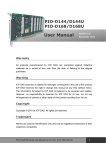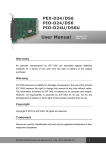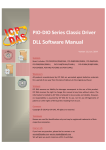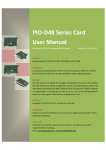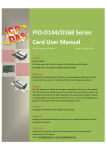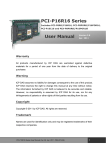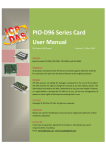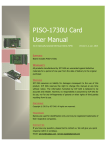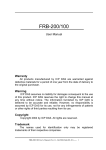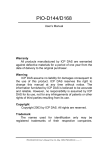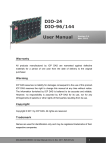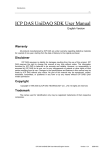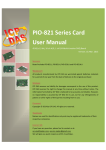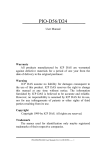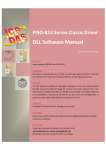Download User Manual - ICP DAS USA`s I
Transcript
PEX-D48 PIO-D48/D48U User Manual Version 3.1 Mar. 2012 Warranty All products manufactured by ICP DAS are warranted against defective materials for a period of one year from the date of delivery to the original purchaser. Warning ICP DAS assumes no liability for damages consequent to the use of this product. ICP DAS reserves the right to change this manual at any time without notice. The information furnished by ICP DAS is believed to be accurate and reliable. However, no responsibility is assumed by ICP DAS for its use, nor for any infringements of patents or other rights of third parties resulting from its use. Copyright Copyright © 2012 by ICP DAS. All rights are reserved. Trademark Names are used for identification only and may be registered trademarks of their respective companies. PIO/PEX-D48 Series User Manual (Ver.3.1, Mar. 2012, PMH-006-31 ) 1 Tables of Contents 1. INTRODUCTION ...........................................................................................................................4 1.1 SPECIFICATIONS ..........................................................................................................................5 1.2 FEATURES ...................................................................................................................................6 1.3 PRODUCT CHECK LIST.................................................................................................................7 2. HARDWARE CONFIGURATION ...............................................................................................8 2.1 BOARD LAYOUT & DEFAULT SETTINGS ......................................................................................8 2.2 I/O PORT LOCATION ....................................................................................................................9 2.3 PIN ASSIGNMENTS .....................................................................................................................10 2.4 ENABLE I/O OPERATION ...........................................................................................................12 2.5 D/I/O ARCHITECTURE ...............................................................................................................13 2.6 INTERRUPT OPERATION .............................................................................................................14 2.6.1 Interrupt Block Diagram for the PIO-D48(U)/PEX-D48 ...................................................15 2.6.2 INT_CHAN_0......................................................................................................................16 2.6.3 INT_CHAN_1......................................................................................................................17 2.6.4 INT_CHAN_2......................................................................................................................18 2.6.5 INT_CHAN_3......................................................................................................................19 2.7 CARD ID SWITCH ......................................................................................................................20 2.8 DAUGHTER BOARDS ..................................................................................................................21 2.8.1 DB-37..................................................................................................................................21 2.8.2 DN-37 and DN-50...............................................................................................................21 2.8.3 DB-8125..............................................................................................................................22 2.8.4 ADP-37/PCI & ADP-50/PCI ..............................................................................................22 2.8.5 DB-24P, DB-24PD Isolated Input Board ...........................................................................23 2.8.6 DB-24R, DB-24RD Relay Board ........................................................................................24 2.8.7 Daughter Board Comparison Table ...................................................................................25 3. I/O CONTROL REGISTER ........................................................................................................26 3.1 HOW TO FIND THE I/O ADDRESS ...............................................................................................26 3.2 THE ASSIGNMENT OF THE I/O ADDRESS ....................................................................................28 3.3 THE I/O ADDRESS MAP .............................................................................................................30 3.3.1 RESET\ Control Register ....................................................................................................31 3.3.2 AUX Control Register .........................................................................................................31 3.3.3 AUX Control Register .........................................................................................................31 3.3.4 INT Mask Control Register .................................................................................................32 PIO/PEX-D48 Series User Manual (Ver.3.1, Mar. 2012, PMH-006-31 ) 2 3.3.5 Aux Status Register .............................................................................................................32 3.3.6 Interrupt Polarity Control Register ....................................................................................33 3.3.7 Read/Write 8255-1 & 8255-2 (I/O port) .............................................................................34 3.3.8 Read/Write 8254 .................................................................................................................35 3.3.9 Read/Write Clock/Int Control Register...............................................................................37 3.3.10 Read Card ID Register........................................................................................................37 4. 5. SOFTWARE INSTALLATION ..................................................................................................38 4.1 SOFTWARE INSTALLING PROCEDURE ........................................................................................38 4.2 PNP DRIVER INSTALLATION ......................................................................................................39 4.3 CONFIRM THE SUCCESSFUL INSTALLATION ...............................................................................40 DEMO PROGRAMS FOR WINDOWS........................................................................................41 APPENDIX ................................................................................................................................................42 APPENDIX A. RELATED DOS SOFTWARE ...............................................................................................42 A1. Where is the related software.............................................................................................42 A2. DOS LIB Functions............................................................................................................43 PIO/PEX-D48 Series User Manual (Ver.3.1, Mar. 2012, PMH-006-31 ) 3 1. Introduction The PIO-D48U/PEX-D48 is the new generation product that ICP DAS provides to meet RoHS compliance requirement and is designed as completely compatible with the PIO-D48. Users can replace the PIO-D48 by the PIOD48U/PEX-D48 directly without software/driver modification. The PIO-D48U supports 3.3 V/5 V PCI bus, while the PEX-D48 supports PCI Express bus. These cards provide 48 TTL digital I/O lines, and these lines are grouped into six 8-bit bi-direction ports. Every three 8-bit ports are grouped as port A (PA), port B (PB) and port C (PC) on a connector, and the port C can be split into 2 nibble-wide(4-bit) parts. All ports are configured as inputs upon power-up or reset. The PIO-D48U/PEX-D48 also adds a Card ID switch and pull-high/ pull-low resisters for DI on board. Users can set Card ID on a board and recognize the board by the ID via software when using two or more PIO-D48U/PEX-D48 cards in one computer. The pull-high/ pull-low resisters allow the DI status to be specified when the DI channels are unconnected; the DI status will remain in high or low status other than floating. The PIO-D48/D48U and PEX-D48 have one D-Sub connector and one 50-pin flat-cable header. The header can be connected to a 50-pin flat-cable. The flatcable can be connected to either an ADP-37/PCI or an ADP-50/PCI adapter. The adapter can then be fixed onto the chassis. This can then can be installed into a 5 V PCI bus and supports actual “Plug & Play” technology. PIO/PEX-D48 Series User Manual (Ver.3.1, Mar. 2012, PMH-006-31 ) 4 1.1 Specifications Model Name PIO-D48 PIO-D48U PEX-D48 Programmable Digital I/O Channels 48 Digital Input Compatibility 5 V/TTL Input Voltage Logic 0: 0.8 V max. Logic 1: 2.0 V min. Response Speed 1.2 kHz / MHz (Typical) Digital Output Compatibility 5 V/TTL Output Voltage Logic 0: 0.4 V max. Logic 1: 2.4 V min. Output Capability Sink: 64 mA @ 0.8 V Source: 32 mA @ 2.0 V Response Speed 1.2 kHz / MHz (Typical) Timer/Counter Channels 2(Event Timer x 1/32-bit Timer x 1) Resolution 16-bit Compatibility 5 V/TTL Reference Clock Internal: 4 MHz General Bus Type 5 V PCI, 32-bit, 3.3 V/5 V Universal 33 MHz PCI, 32-bit, 33 MHz Data Bus Card ID I/O Connector Dimensions (L x W x D) Power Consumption Operating Temperature Storage Temperature Humidity PCI Express x1 8-bit No Yes(4-bit) Female DB37 x 1 50-pin box header x 1 156 mm x 105 mm x 22 mm 900 mA @ +5 V 0 ~ 60 °C -20 ~ 70 °C 5 ~ 85% RH, non-condensing PIO/PEX-D48 Series User Manual (Ver.3.1, Mar. 2012, PMH-006-31 ) 5 1.2 Features Support the +5 V PCI bus for PIO-D48 Support the +5 V and +3.3 V PCI bus for PIO-D48U Supports PCI Express x 1 for PEX-D48 48 channels of digital I/O Bi-direction programmable I/O ports under software control All I/O lines buffered on the board Six 8-bit bi-direction I/O ports SMD, short card Connects directly to DB-24P, DB-24R, DB-24PR, DB-24PD, DB-24RD, DB-24PRD, DB-16P8R, DB-24POR, DB-24SSR, DB-24C or any OPTO-22 compatible daughter boards One 32-bit programmable internal timer One DB37 connector, one 50-pin box header One 16-bit event counter Interrupt source: 4-channel Pull-up or pull-down resistors on I/O lines Emulates two industrial-standard 8255 PPI ports (mode 0) Buffer output for a higher driving capability Card ID function for PIO-D48U/PEX-D48 DIO response time is about 0.77 μs (1.3 MHz max.) PIO/PEX-D48 Series User Manual (Ver.3.1, Mar. 2012, PMH-006-31 ) 6 1.3 Product Check List The shipping package includes the following items: One PIO-D48 series or PEX-D24/D56 card One software utility PCI CD. One Quick Start Guide It is recommended that you read the Quick Start Guide first. All the necessary and essential information is given in the Quick Start Guide, including: Where to get the software driver, demo programs and other resources. How to install the software. How to test the card. Attention! If any of these items is missing or damaged, contact the dealer from whom you purchased the product. Please save the shipping materials and carton in case you need to ship or store the product in the future. PIO/PEX-D48 Series User Manual (Ver.3.1, Mar. 2012, PMH-006-31 ) 7 2. Hardware configuration 2.1 Board Layout & Default Settings 2 3 SW1 1 1 JP6 (Port4) Pull-High 3 3 Pull-Low Pull-High 50-pin PA= Port0 PB= Port1 PC= Port2 2 2 JP7 (Port5) Pull-Low 1 1 Pull-High 3 Pull-Low 2 3 JP3 (Port2) Pull-High 2 CN1 JP4 (Port1) CN2 Pull-Low 1 2 3 4 DB-37 PA= Port0 PB= Port1 PC= Port2 Pull-High 3 JP5 (Port3) 2 1 Only for PIO-D48U 1 JP2 (Port0) Pull-High PIO-D48 PIO-D48U Pull-Low The board layout of the PIO-D48/D48U cards are shown below: Pull-Low Figure 2.1 2 3 SW1 1 1 Pull-High Pull-High 50-pin PA= Port0 PB= Port1 PC= Port2 2 2 3 3 Pull-Low JP7 (Port5) Pull-Low 1 1 Pull-High 3 Pull-Low JP6 (Port4) 2 3 JP3 (Port2) 2 CN1 DB-37 PA= Port0 PB= Port1 PC= Port2 Pull-High CN2 Pull-Low 1 2 3 4 JP4 (Port1) Pull-High 3 JP5 (Port3) 2 1 1 JP2 (Port0) Pull-High PEX-D48 Pull-Low The board layout of the PEX-D48 cards are shown below: Pull-Low Figure 2.2 ※ Default Setting: JP2/3/4/5/6/7=2-3 short = Pull-Low PIO/PEX-D48 Series User Manual (Ver.3.1, Mar. 2012, PMH-006-31 ) 8 2.2 I/O Port Location There are six 8-bit I/O ports in the PIO-D48/D48U and PEX-D48. Each I/O port can be programmed as a D/I or D/O port. When the PC is first powered-on or reset, all the ports are configured as D/I ports. These D/I ports can be selected to either pull-high or pull-low via placement of the JP2 ~ JP7 jumpers. These I/O port locations are given as follows: Table 2.1 Connector CN1 (DB-37) PA0 to PA7 port-0 PB0 to PB7 PC0 to PC7 port-1 port-2 (pull-high/low by JP2) (pull-high/low by JP3) (pull-high/low by JP4) CN2 port-3 port-4 port-5 (50-pin head) (pull-high/low by JP5) (pull-high/low by JP6) (pull-high/low by JP7) Note: Refer to Sec. 2.1 for the board layout and I/O port locations. Refer to Sec. 2.1 for JP 2 ~ 7 pull-high/pull-low placements. PIO/PEX-D48 Series User Manual (Ver.3.1, Mar. 2012, PMH-006-31 ) 9 2.3 Pin Assignments The pin assignments for all connectors on the PIO-D48/D48U and PEX-D48 are represented in Figures 2.3 and 2.4. All signal sources for each digital input or output pin (channel) is TTL compatible. CN1: 37 pin D-type female connector (port-0, port-1, port2) Port-0 = PA0 ~ PA7; Port-1 = PB0 ~ PB7; Port-2 = PC0~PC7 PA _0 PA _1 PA _2 PA _3 PA _4 PA _5 PA _6 PA_7 PC _0 PC _1 PC_2 PC_3 PC_4 PC _5 PC _6 PC _7 GND VCC 19 18 17 16 15 14 13 12 11 10 9 8 7 6 37 36 35 34 33 32 31 30 29 28 27 26 25 24 23 22 21 20 5 4 3 2 1 GND VCC GN D N.C . GND N.C. GN D N .C. GN D P B_0 P B_1 P B_2 P B_3 P B_4 P B_5 P B_6 P B_7 N .C. N .C. Figure 2.3 PIO/PEX-D48 Series User Manual (Ver.3.1, Mar. 2012, PMH-006-31 ) 10 CN2: 50-pin flat-cable connector (port-3, port-4, port-5) Port-3 = PA0 ~ PA7; Port-4 = PB0 ~ PB7; Port-5 = PC0~PC7 GND GND GND GND GND GND GND GND GND GND GND GND GND GND GND GND GND GND GND GND GND GND GND GND GND 49 47 45 43 41 50 48 46 44 42 40 38 36 34 32 30 28 26 24 39 37 35 33 31 29 27 25 23 21 22 20 18 16 14 12 10 8 6 4 2 19 17 15 13 11 9 7 5 3 1 V CC PA _ 0 PA_1 PA_2 PA _ 3 PA _ 4 PA _ 5 PA_6 PA_7 P B_0 P B_1 P B_2 P B_3 P B_4 P B_5 P B_6 P B_7 P C_0 P C_1 P C_2 P C_3 P C_4 P C_5 P C_6 P C_7 Figure 2.4 PIO/PEX-D48 Series User Manual (Ver.3.1, Mar. 2012, PMH-006-31 ) 11 2.4 Enable I/O Operation When the PC is first turned on, all operations involved with digital I/O channels are disabled. Note that the digital I/O channels are enabled or disabled by the RESET\ signal, (refer to Sec. 3.3.1 for more information related to this). The power-on states are given as follows: D/I/O operations for each port are disabled. D/I/O ports are all configured as Digital input ports. D/O latch register outputs are all at high impedance.(refer to Sec. 2.5) The user has to perform some initialization before using these digital I/O ports. The recommended steps are given below: Step 1: Find the address-mapping for PIO/PISO cards. (Refer to Sec.3.1) Step 2: Enable all Digital I/O operations. (Refer to Sec. 3.3.1). Step 3: Configure the first three ports to their expected D/I/O states & send their initial values to every D/O port (Refer to Sec. 3.3.7) Step 4: Configure the other three ports to their expected D/I/O states & send their initial values to every D/O port (Refer to Sec. 3.3.7) For more information on the initial procedure for digital I/O ports, please refer to the DIO demo program. PIO/PEX-D48 Series User Manual (Ver.3.1, Mar. 2012, PMH-006-31 ) 12 2.5 D/I/O Architecture The digital I/O control architecture for the PIO-D48/D48U and PEX-D48 are demonstrated in Figure 2.5. The operation method used for the control signal is presented as below. RESET\ is in the Low-state Æ all D/I/O operations are disabled. RESET\ is in the High-state Æ all D/I/O operations are enabled. If D/I/O is configured as a D/I port Æ D/I= external input signal. Æ Can be selected as either pull-high or pull-low as chosen by placement of the JP2/3/4/5/6/7 jumpers (shorted 1-2= pull-high; shorted 2-3 = pull-low). If D/I/O is configured as a D/O port Æ D/I = read back D/O If D/I/O is configured as a D/I port Æ sending data to a Digital input port will only change the D/O latch register. The latched data will be output when the port is configured as digital output and is activated right away. Figure 2.5 PIO/PEX-D48 Series User Manual (Ver.3.1, Mar. 2012, PMH-006-31 ) 13 2.6 Interrupt Operation There are four interrupt sources in the PIO-D48/D48U and PEX-D48. These four signals are named INT_CHAN_0, INT_CHAN_1, INT_CHAN_2 and INT_CHAN_3. Their signal sources are given as follows: INT_CHAN_0: PC3/PC7 from port-2(refer to Sec. 2.6.2) INT_CHAN_1: PC3/PC7 from port-5(refer to Sec. 2.6.3) INT_CHAN_2: Cout0(refer to Sec. 2.6.4) INT_CHAN_3: Cout2(refer to Sec. 2.6.5) Note that DEMO4.C, DEMO7.C, DEMO8.C, DEMO9.C and DEMO10.C are demo programs for a single interrupt source and DEMO11.C is the demo program for more than one interrupt source in the DOS operating system. If only one interrupt signal source is used, the interrupt service routine does not need to identify the interrupt source. However, if there are more than one interrupt source, the interrupt service routine has to identify the active signals in the following manner: 1. Read the new status of all interrupt signal sources. (refer to Sec 3.3.5) 2. Compare the new status with the old status to identify the active signals. 3. If INT_CHAN_0 is active, service INT_CHAN_0 & non-inverter/inverted the INT_CHAN_0 signal. 4. If INT_CHAN_1 is active, service INT_CHAN_1 & non-inverted/inverted the INT_CHAN_1 signal. 5. If INT_CHAN_2 is active, service INT_CHAN_2 & non-inverted/inverted the INT_CHAN_2 signal. 6. If INT_CHAN_3 is active, service INT_CHAN_3 & non-inverted/inverted the INT_CHAN_3 signal. 7. Update the interrupt status Limitation: If the interrupt signal is too short, the new status may be the same as the old status. So the interrupt signal must be held active until the interrupt service routine has been executed. This hold time is different for differing operating systems. The hold time can be as short as a micro-second or as long as 1 second. In general, 20ms is enough for all O.S. PIO/PEX-D48 Series User Manual (Ver.3.1, Mar. 2012, PMH-006-31 ) 14 2.6.1 Interrupt Block Diagram for the PIO-D48(U)/PEX-D48 Figure 2.6 The INT\ interrupt output signals are level-trigger and Active_Low. If the INT\ generates a low-pulse, the PIO-D48/D48U and PEX-D48 will interrupt the PC once per occasion. If the INT\ is fixed in low level, the PIO-D48/D48U and PEXD48 will interrupt the PC continuously. So the INT_CHAN_0/1/2/3 must be controlled with pulse_type signals. They should normally be fixed in a low level state and generate a high_pulse to interrupt the PC. The priority of INT_CHAN_0/1/2/3 is the same. If all these four signals are active at the same time, then INT\ will be active only once per occasion. So the interrupt service routine has to read the status for all interrupt channels for multichannel interruptions. (Refer to Sec. 2.6 for more information). DEMO11.C Æ for both INT_CHAN_0 & INT_CHAN_1 If only one interrupt source is used, the interrupt service routine doesn’t have to read the interrupt source status. Note that DEMO4.C to DEMO10.C is demo programs for a single-channel interruption within the DOS operating system. DEMO4.C Æ for INT_CHAN_3 only DEMO7.C Æ for INT_CHAN_2 only DEMO8.C Æ for INT_CHAN_0 only DEMO9.C Æ for INT_CHAN_0 only DEMO10.C Æ for INT_CHAN_1 only PIO/PEX-D48 Series User Manual (Ver.3.1, Mar. 2012, PMH-006-31 ) 15 2.6.2 INT_CHAN_0 Figure 2.7 INT_CHAN_0 should normally be fixed in a low level state and generate a high_pulse to interrupt the PC. INT_CHAN_0 can be equal to PC3&!PC7 or be PC3 programmable as is shown below :(Refer to Sec. 3.3.9) CTRL_D3=0, CTRL_D2=1 Æ INT_CHAN_0=disable CTRL_D3=1, CTRL_D2=0 Æ INT_CHAN_0=PC3 of port-2 CTRL_D3=0, CTRL_D2=0 Æ INT_CHAN_0=PC3&!PC7 of port-2 EN0 can be used to enable/disable the INT_CHAN_0 as follows: (Refer to Sec. 3.3.4) EN0=0 Æ INT_CHAN_0=disabled EN0=1 Æ INT_CHAN_0=enabled INV0 can be used to invert/non-invert the PC3 or PC3&!PC7 as follows: (Refer to Sec. 3.3.6) INV0=0 Æ INT_CHAN_0=inverted state of (PC3 or PC3&!PC7 of port-2) INV0=1 Æ INT_CHAN_0=non-inverted state of (PC3 or PC3&!PC7 of port-2) Refer to the following demo programs for more information: DEMO8.C Æ for INT_CHAN_0 only (PC3 of port-2) DEMO9.C Æ for INT_CHAN_0 only (PC3&!PC7 of port-2) PIO/PEX-D48 Series User Manual (Ver.3.1, Mar. 2012, PMH-006-31 ) 16 2.6.3 INT_CHAN_1 Figure 2.8 INT_CHAN_1 should normally be fixed in low level state and generate a high_pulse to interrupt the PC. INT_CHAN_1 can be equal to PC3&!PC7 or be PC3 programmable as is shown below:(Refer to Sec. 3.3.9) CTRL_D5=0, CTRL_D4=1 Æ INT_CHAN_1=disabled CTRL_D5=1, CTRL_D4=0 Æ INT_CHAN_1=PC3 of port-5 CTRL_D5=0, CTRL_D4=0 Æ INT_CHAN_1=PC3&!PC7 of port-5 EN1 can be used to enable/disable the INT_CHAN_1 as follows: (Refer to Sec. 3.3.4) EN1=0 Æ INT_CHAN_1=disabled EN1=1 Æ INT_CHAN_1=enabled INV1 can be used to invert/non-invert the PC3 or PC3&!PC7 as follows: (Refer to Sec. 3.3.6) INV1=0 Æ INT_CHAN_1=inverted state of (PC3 or PC3&!PC7 of port-5) INV1=1 Æ INT_CHAN_1=non-inverted state of (PC3 or PC3&!PC7 of port-5) Refer to the following demo program for more information: DEMO10.C Æ for INT_CHAN_1 only (PC3&!PC7 of port-5) NOTE: Refer to Sec. 2.6.2 for active high-pulse generation. PIO/PEX-D48 Series User Manual (Ver.3.1, Mar. 2012, PMH-006-31 ) 17 2.6.4 INT_CHAN_2 Figure 2.9 INT_CHAN_2 should normally be fixed in a low-level state and generate a high_pulse to interrupt the PC. PC0 (port-2) can be inverted/non-inverted programmable as is shown below: (Refer to Sec. 3.3.9) CTRL_D1=0 Æ Cin0=PC0 of port-2 CTRL_D1=1 Æ Cin0=!PC0 of port-2 EN2 can be used to enable/disable the INT_CHAN_2 as follows: (Refer to Sec. 3.3.4) EN2=0 Æ INT_CHAN_2=disabled EN2=1 Æ INT_CHAN_2=enabled INV2 can be used to invert/non-invert the Cout0 as follows: (Refer to Sec. 3.3.6) INV2=0 Æ INT_CHAN_2=inverted state of (Cout0) INV2=1 Æ INT_CHAN_2=non-inverted state of (Cout0) Refer to the following demo program for more information: DEMO7.C Æ for INT_CHAN_2 only (Cout0) NOTE: Refer to Sec. 2.6.2 for active high-pulse generation. PIO/PEX-D48 Series User Manual (Ver.3.1, Mar. 2012, PMH-006-31 ) 18 2.6.5 INT_CHAN_3 Figure 2.10 INT_CHAN_3 should normally be fixed in a low-level state and generate a high_pulse to interrupt the PC. Cin1 can be 2M/32768Hz programmable as is given below: (Refer to Sec. 3.3.9) CTRL_D0=0 Æ Cin1=2 M clock source CTRL_D0=1 Æ Cin1=32768 Hz clock source EN3 can be used to enable/disable the INT_CHAN_3 as follows: (Refer to Sec. 3.3.4) EN3=0 Æ INT_CHAN_3=disabled EN3=1 Æ INT_CHAN_3=enabled INV3 can be used to invert/non-invert the Cout0 as follows: (Refer to Sec. 3.3.6) INV2=3 Æ INT_CHAN_3=invert (Cout2) INV2=3 Æ INT_CHAN_3=non-invert (Cout2) Refer to the following demo program for more information: DEMO4.C Æ for INT_CHAN_3 only (Cout2) NOTE: Refer to Sec. 2.6.2 for active high-pulse generation. PIO/PEX-D48 Series User Manual (Ver.3.1, Mar. 2012, PMH-006-31 ) 19 2.7 Card ID Switch The PIO-D48U and PEX-D48 has a Card ID switch with which users can recognize the board by the ID via software when using two or more PIO-D48U and PEX-D48 cards in one computer. The default Card ID is 0x0. For detail SW1 Card ID settings, please refer to Table 2.2. NO ID 2 ID 3 ID 1 ID 0 SW1 1 2 3 4 (Default Settings) Table 2.2 (*) Default Settings; OFF Æ 1; ON Æ 0 Card ID 1 2 3 (Hex) ID0 ID1 ID2 (*) 0x0 ON ON ON 4 ID3 ON 0x1 OFF ON ON ON 0x2 ON OFF ON ON 0x3 OFF OFF ON ON 0x4 ON ON OFF ON 0x5 OFF ON OFF ON 0x6 ON OFF OFF ON 0x7 OFF OFF OFF ON 0x8 ON ON ON OFF 0x9 OFF ON ON OFF 0xA ON OFF ON OFF 0xB OFF OFF ON OFF 0xC ON ON OFF OFF 0xD OFF ON OFF OFF 0xE ON OFF OFF OFF 0xF OFF OFF OFF OFF PIO/PEX-D48 Series User Manual (Ver.3.1, Mar. 2012, PMH-006-31 ) 20 2.8 Daughter Boards 2.8.1 DB-37 The DB-37 is a general purpose daughter board for D-sub 37 pins. It is designed for easy wire connection via pin-to-pin. Figure 2.11 2.8.2 DN-37 and DN-50 The DN-37 is a general purpose daughter board for DB-37 pins with DIN-Rail Mountings. The DN-50 is designed for 50-pin flat-cable headers win DIN-Rail mountings. They are also designed for easy wire connection via pin-to-pin. Figure 2.12 PIO/PEX-D48 Series User Manual (Ver.3.1, Mar. 2012, PMH-006-31 ) 21 2.8.3 DB-8125 The DB-8125 is a general purpose screw terminal board. It is designed for easy wire connection. The DB-8125 consists of one DB-37 and two 20-pin flat-cable headers. Figure 2.13 2.8.4 ADP-37/PCI & ADP-50/PCI The ADP-37/PCI & ADP-50/PCI are extenders for the 50-pin header. The one side of the ADP-37/PCI or the ADP-50/PCI can be connected to a 50-pin header. The other side can be mounted onto the PC chassis as is depicted by the following: Figure 2.14 ADP-37/PCI: 50-pin header to DB-37 extender. ADP-50/PCI: 50-pin header to 50-pin header extender. PIO/PEX-D48 Series User Manual (Ver.3.1, Mar. 2012, PMH-006-31 ) 22 2.8.5 DB-24P, DB-24PD Isolated Input Board The DB-24P is a 24-channel isolated digital input daughter board. The optically isolated inputs of the DB-24P consist of a bi-directional optocoupler with a resistor for current sensing. You can use the DB-24P to sense DC signals from TTL levels up to 24 V or use the DB-24P to sense a wide range of AC signals. You can also use this board to isolate the computer from large common-mode voltage, ground loops and transient voltage spikes that often occur in industrial environments, as shown in Figure 2.15. Table 2.3 is the comparison of DB-24P and DB-24PD. PIO-D48/D48U PEX-D48 PIO-D48/D48U PEX-D48 Figure 2.15 Table 2.3 50-pin flat-cable header D-sub 37-pin header Other specifications DB-24P Yes No DB-24PD Yes Yes Same PIO/PEX-D48 Series User Manual (Ver.3.1, Mar. 2012, PMH-006-31 ) 23 2.8.6 DB-24R, DB-24RD Relay Board The DB-24R, 24-channel relay output board, consists of 24 form-C relays for efficiently controlling the switch with the use of an appropriately loaded program. The relays are energized by applying a 12 V/24 V voltage signal to the appropriate relay channel on the 50-pin flat-cable connector. There are 24 enunciator LED’s for each relay channel and the LED light will go on when their associated relay has been activated. The control scheme is illustrated below. Figure 2.16 Table 2.4 50-pin flat-cable header D-sub 37-pin header Other specifications DB-24R Yes No DB-24RD Yes Yes Same Table 2.5 DB-24R, DB-24RD DB-24PR,DB-24PRD DB-24POR 24*Relay (120 V, 0.5 A) 24* Power Relay (250 V, 5 A) 24*photo MOS Relay (350 V, 0.1 A) DB-24SSR 24*SSR (250 VAC, 4 A) PIO/PEX-D48 Series User Manual (Ver.3.1, Mar. 2012, PMH-006-31 ) 24 2.8.7 Daughter Board Comparison Table Table 2.6 ! 20-pin flat-cable header 50-pin flat-cable header DB-37 Header DB-37 No No Yes DN-37 No No Yes ADP-37/PCI No Yes Yes ADP-50/PCI No Yes No DB-24P No Yes No DB-24PD No Yes Yes DB-16P8R No Yes Yes DB-24R No Yes No DB-24RD No Yes Yes DB-24C Yes Yes Yes DB-24PR Yes Yes No Db-24PRD No Yes Yes DB-24POR Yes Yes Yes DB-24SSR No Yes Yes NOTE: There is no 20-pin header in the PIO-D48/D48U and PEX-D48. The PIO-D48/D48U and PEX-D48 has one DB-37 connector and one 50 pin flat-cable header. PIO/PEX-D48 Series User Manual (Ver.3.1, Mar. 2012, PMH-006-31 ) 25 3. I/O Control Register 3.1 How to Find the I/O Address The plug & play BIOS will assign a proper I/O address to every PIO/PISO series card in the power-on stage. The IDs for the PIO-D48/D48U and PEX-D48 cards are given as follows: PIO-D48/D48U, PEX-D48 Rev 1.x Vendor ID 0xE159 Device ID 0x0002 Sub-vendor ID 0x80 Sub-device ID 0x01 Sub-aux ID 0x30 Rev 2.0 or above Vendor ID Device ID Sub-vendor ID Sub-device ID Sub-aux ID 0xE159 0x0001 0x0080 0x01 0x30 The PIO_PISO.EXE utility program will detect and present all information for PIO/PISO cards installed in the PC, as shown in the following Figure3.1. Details of how to identify the PIO series cards of ICPDAS data acquisition boards based on the Sub-vendor, Sub-device and Sub-Aux ID are given in Table 3-1. The PIO_PISO.exe utility is located on the CD as below and is useful for all PIO/PISO series cards. (CD:\NAPDOS\PCI\Utility\Win32\PIO_PISO\ ) http://ftp.icpdas.com/pub/cd/iocard/pci/napdos/pci/utility/win32/pio_piso/ Figure 3.1 PIO/PEX-D48 Series User Manual (Ver.3.1, Mar. 2012, PMH-006-31 ) 26 Table 3-1 PIO/PISO series card PIO-D168 PIO-D168A PIO-D144(REV4.0) PIO-D96 (REV4.0) PIO-D64 (REV2.0) PIO-D56 (REV5.0) PIO-D48 (REV2.0) PIO-D24 (REV6.0) PIO-821 PIO-DA16 PIO-DA8 PIO-DA4 PISO-C64 PISO-A64 PISO-P64 PISO-P32C32 PISO-P32A32 PISO-P8R8 PISO-P8SSR8AC PISO-P8SSR8DC PISO-730 PISO-730A PISO-813 PISO-DA2 ! Description 168 * DIO 168 * DIO 144 * D/I/O 96 * D/I/O 64 * D/I/O 24 * D/I/O + 16 * D/I+16*D/O 48 * D/I/O 24 * D/I/O Multi-function 16 * D/A 8 * D/A 4 * D/A 64 * isolated D/O (Current sinking) 64 * isolated D/O (Current sourcing) 64 * isolated D/I 32* isolated D/O (Current sinking) + 32* isolated D/I 32*isolated DO (Current sourcing) + 32* isolated D/I 8* isolated D/I + 8 * 220 V relay 8* isolated D/I + 8 * SSR /AC 8* isolated D/I + 8 * SSR /DC 16*DI + 16*D/O + 16* isolated D/I + 16*isolated D/O (Current sinking) 16*DI + 16*D/O + 16* isolated D/I + 16*isolated D/O (Current sourcing) 32 * isolated A/D 2 * isolated D/A Sub_Vendor Sub_Device Sub_AUX 9880 80 80 (5C80) 80 (5880) 80 (4080) 80 (8080) 01 01 01 01 01 01 50 50 00 10 20 40 80 (0080) 80 (8080) 80 80 80 80 80 01 01 03 04 04 04 08 30 40 10 00 00 00 00 80 08 50 80 80 08 08 10 20 80 08 70 80 08 30 80 08 30 80 08 30 80 08 40 80 08 80 80 80 0A 0B 00 00 Note: If your board is a different version, it may also have different Sub IDs. However this will present no actual problem. No matter which version of the board you select, we offer the same function calls. PIO/PEX-D48 Series User Manual (Ver.3.1, Mar. 2012, PMH-006-31 ) 27 3.2 The Assignment of the I/O Address The Plug & Play BIOS will assign the proper I/O address to a PIO/PISO series card. If there is only one PIO/PISO board, the user can identify the board as card_0. If there are two PIO/PISO boards in the system, it is very difficult to identify which board is card_0. The software driver can support a maximum of 16 boards. Therefore, the user can install 16 PIO/PSIO series cards onto one PC system. The methods used to find and identify card_0 and card_1 is demonstrated below: The simplest way to identify which card is card_0 is to use wSlotBus & wSlotDevice in the following manner: Step1: Remove all PIO-D48/D48U and PEX-D48 boards from the PC. Step2: Install one PIO-D48/D48U and PEX-D48 onto the PC’s PCI_slot1, run PIO_PISO.EXE. Then record the wSlotBus1 and wSlotDevice1 information. Step3: Remove all PIO-D48/D48U and PEX-D48 boards from the PC. Step4: Install one PIO-D48/D48U and PEX-D48 into the PC’s PCI_slot2 and run PIO_PISO.EXE. Then record the wSlotBus2 and wSlotDevice2 information. Step5: Repeat steps (3) and (4) for every PCI_slot and record the information from wSlotBus and wSlotDevice. PIO/PEX-D48 Series User Manual (Ver.3.1, Mar. 2012, PMH-006-31 ) 28 The records may look similar to the table below: Table 3-2 PC’s PCI slot wSlotBus wSlotDevice Slot_1 0 0x07 Slot_2 0 0x08 Slot_3 0 0x09 Slot_4 0 0x0A Slot_5 1 0x0A Slot_6 1 0x08 Slot_7 1 0x09 Slot_8 1 0x07 PCI-BRIDGE The above procedure is used to record all the wSlotBus and wSlotDevice information for the PC. These values will be mapped to this PC’s physical slots and this mapping will not be changed for any PIO/PISO cards. Therefore, this information can be used to identify the specific PIO/PISO card using the following steps: Step 1: Using the wSlotBus and wSlotDevice information from Table 3-2, enter the board number into the PIO_GetConfigAddressSpace(…) function to get the information for a specific card information, especially wSlotBus and wSlotDevice details. Step 2: Identify the specific PIO/PISO card by comparing the data of the wSlotBus and wSlotDevice from Step 1. ! Note that, normally, the card that is installed in slot 0 is card0 and the card installed in slot1 is card1 for PIO/PISO series cards. PIO/PEX-D48 Series User Manual (Ver.3.1, Mar. 2012, PMH-006-31 ) 29 3.3 The I/O Address Map The I/O address for PIO/PISO series cards are automatically assigned by the main board ROM BIOS. The I/O address can also be re-assigned by the user. It is strongly recommended that users do not change the I/O address. The Plug & Play BIOS will effectively perform the assignment of proper I/O addresses to each PIO/PISO series card. The I/O addresses for the PIO-D48/D48U and PEXD48 are given in the table below, which are based on the base address of each card. Table 3.3 Address Read wBase+0 Write RESET\ control register wBase+2 Aux control register Same wBase+3 Aux data register Same wBase+5 INT mask control register Same wBase+7 Aux pin status register Same wBase+0x2a INT polarity control register Same wBase+0xc0 Read 8255-1-PA(port-0) Write 8255-1-PA(port-0) wBase+0xc4 Read 8255-1-PB(port-1) Write 8255-1-PB(port-1) wBase+0xc8 Read 8255-1-PC(port-2) Write 8255-1-PC(port-2) wBase+0xcc Write 8255-1 control word wBase+0xd0 Read 8255-2-PA(port-3) Write 8255-2-PA(port-3) wBase+0xd4 Read 8255-2-PB(port-4) Write 8255-2-PB(port-4) wBase+0xd8 Read 8255-2-PC(port-5) Write 8255-2-PC(port-5) wBase+0xdc Write 8255-2 control word wBase+0xe0 Read 8254-counter0 Write 8254-counter0 wBase+0xe4 Read 8254-counter1 Write 8254-counter1 wBase+0xe8 Read 8254-counter2 Write 8254-counter2 wBase+0xec Read 8254 control word Write 8254 control word wBase+0xf0 Read clock/int control word Write clock/int control word wBase+0xf4 Read Card ID ※ Note: Refer to Sec. 3.1 for more information about wBase. PIO/PEX-D48 Series User Manual (Ver.3.1, Mar. 2012, PMH-006-31 ) 30 3.3.1 RESET\ Control Register (Read/Write): wBase+0 Bit 7 Bit 6 Bit 5 Bit 4 Bit 3 Bit 2 Bit 1 Bit 0 Reserved Reserved Reserved Reserved Reserved Reserved Reserved RESET\ When the PC’s power is first turned on, RESET\ signal is in a Low-state. This will disable all D/I/O operations. The user has to set the RESET\ signal to a High-state before any D/I/O command applications are initiated. outportb (wBase,1); /* RESET\=High Æ all D/I/O are enable now */ outportb (wBase,0); /* RESET\=Low Æ all D/I/O are disable now */ 3.3.2 AUX Control Register (Read/Write): wBase+2 Bit 7 Bit 6 Bit 5 Bit 4 Bit 3 Bit 2 Bit 1 Bit 0 Aux7 Aux6 Aux5 Aux4 Aux3 Aux2 Aux1 Aux0 Aux?=0Æ this Aux is used as a D/I Aux?=1Æ this Aux is used as a D/O When the PC is first turned on, all Aux signals are in a Low-state. All Aux are designed as D/I for all PIO/PISO series. 3.3.3 AUX Control Register (Read/Write): wBase+3 Bit 7 Bit 6 Bit 5 Bit 4 Bit 3 Bit 2 Bit 1 Bit 0 Aux7 Aux6 Aux5 Aux4 Aux3 Aux2 Aux1 Aux0 When the Aux is used for D/O, the output state is controlled by this register. This register is designed for feature extension. Therefore, do not use this register. PIO/PEX-D48 Series User Manual (Ver.3.1, Mar. 2012, PMH-006-31 ) 31 3.3.4 INT Mask Control Register (Read/Write): wBase+5 Bit 7 Bit 6 Bit 5 Bit 4 Bit 3 Bit 2 Bit 1 Bit 0 0 0 0 0 EN3 EN2 EN1 EN0 EN0=0Æ disable INT_CHAN_0 as a interrupt signal (default) EN0=1Æ enable INT_CHAN_0 as a interrupt signal EN1=0Æ disable INT_CHAN_1 as a interrupt signal (default) EN1=1Æ enable INT_CHAN_1 as a interrupt signal EN2=0Æ disable INT_CHAN_2 as a interrupt signal (default) EN2=1Æ enable INT_CHAN_2 as a interrupt signal EN3=0Æ disable INT_CHAN_3 as a interrupt signal (default) EN3=1Æ enable INT_CHAN_3 as a interrupt signal outportb(wBase+5,0); /* disable all interrupts */ outportb(wBase+5,1); /* enable interrupt of INT_CHAN_0 */ outportb(wBase+5,2); /* enable interrupt of INT_CHAN_1 */ outportb(wBase+5,4); /* enable interrupt of INT_CHAN_2 */ outportb(wBase+5,8); /* enable interrupt of INT_CHAN_3 */ outportb(wBase+5,0x0f); /* enable all four channels of interrupt */ 3.3.5 Aux Status Register (Read/Write): wBase+7 Bit 7 Bit 6 Bit 5 Bit 4 Bit 3 Bit 2 Bit 1 Bit 0 Aux7 Aux6 Aux5 Aux4 Aux3 Aux2 Aux1 Aux0 Aux0=INT_CHAN_0, Aux1=INT_CHAN_1, Aux2=INT_CHAN_2, Aux3=INT_CHAN_3, Aux7~4=Aux-ID. The Aux 0~3 are used as interrupt source. The interrupt service routine has to read this register to identify the interrupt source. Refer to Sec. 2.6 for more information. PIO/PEX-D48 Series User Manual (Ver.3.1, Mar. 2012, PMH-006-31 ) 32 3.3.6 Interrupt Polarity Control Register (Read/Write): wBase+0x2A Bit 7 Bit 6 Bit 5 Bit 4 Bit 3 Bit 2 Bit 1 Bit 0 0 0 0 0 INV3 INV2 INV1 INV0 This register provides a function to control invert or non-invert for the interrupt signal source. A detailed application example is given below. INV0=0Æ select the inverted signal from interrupt_channel_0 INV0=1Æ select the non-inverted signal from interrupt_channel_0 INV1=control interrupt channel_1 INV2=control interrupt channel_2 INV3=control interrupt channel_3 /* select the inverted input from all 4 channel*/ outportb(wBase+0x2a,0); /* select the non-inverted input from all 4 channels*/ outportb(wBase+0x2a,0x0f); /* select the inverted input of INT_CHAN_0 */ /* select the non-inverted input from the others */ outportb(wBase+0x2a,0x0e); /* select the inverted input of INT_CHAN_0 & INT_CHAN_1*/ /* select the non-inverted input from the others */ outportb(wBase+0x2a,0x0c); Refer to Sec. 2.6 and demo5.c for more information. PIO/PEX-D48 Series User Manual (Ver.3.1, Mar. 2012, PMH-006-31 ) 33 3.3.7 Read/Write 8255-1 & 8255-2 (I/O port) 8255 control word (mode-0) (Write): wBase+0xcc / 0xdc Bit 7 Bit 6 Bit 5 Bit 4 Bit 3 Bit 2 Bit 1 Bit 0 1 0 0 PA PC-H 0 PB PC-L There are six 8-bit I/O ports in the PIO-D48/D48U and PEX-D48. Every I/O port can be programmed to be a D/I or a D/O port based on the control word settings. All six ports are configured as D/I ports when the power is first turned on. (Write): wBase+0xcc=8255-1 (Write): wBase+0xdc=8255-2 PA/ PB/ PC-H/ PC-L : 1Æ inport, 0Æ outport. PC-H: high nibble of PC PC-L: low nibble of PC Read/Write 8-bit data of 8255 (Read/Write):wBase+0xc0/0xc4/0xc8/0xd0/0xd4/0xd8 Bit 7 Bit 6 Bit 5 Bit 4 Bit 3 Bit 2 Bit 1 Bit 0 D7 D6 D5 D4 D3 D2 D1 D0 (Read/Write): wBase+0xc0=8255-1-PA Æ port_0 (Read/Write): wBase+0xc4=8255-1-PB Æ port_1 (Read/Write): wBase+0xc8=8255-1-PC Æ port_2 (Read/Write): wBase+0xd0=8255-2-PA Æ port_3 (Read/Write): wBase+0xd4=8255-2-PB Æ port_4 (Read/Write): wBase+0xd8=8255-2-PC Æ port_5 outportb(wBase+0xcc,0x80); outportb(wBase+0xc0,V1); outportb(wBase+0xc4,V2); outportb(wBase+0xc8,V3); /* port-0, port-1, port-2 are D/O port */ /* write to port_0 (PA) */ /* write to port_1 (PB) */ /* write to port_2 (PC) */ outportb(wBase+0xdc,0x9B); V1=inportb(wBase+0xd0); V2=inportb(wBase+0xd4); V3=inportb(wBase+0xd8); /* port-3, port-4, port-5 are D/I port */ /* read from port_3 (PA) */ /* read from port_4 (PB) */ /* read from port_5 (PC) */ PIO/PEX-D48 Series User Manual (Ver.3.1, Mar. 2012, PMH-006-31 ) 34 3.3.8 Read/Write 8254 8254 control word (Read/Write): wBase+0xec Bit 7 Bit 6 Bit 5 Bit 4 Bit 3 Bit 2 Bit 1 Bit 0 SC1 SC0 RL1 RL0 M2 M1 M0 BCD [BCD]: 0: binary count 1: BCD count [M2, M1, M0]: 000:mode0 001:mode1 010:mode2 011:mode3 100:mode4 101:mode5 interrupt on terminal count programmable one-shot rate generator square-wave generator software triggered pulse hardware triggered pulse [RL1, RL0]: 00: 01: 10: 11: counter latch instruction read/write low counter byte only read/write high counter byte only read/write low counter byte first, then high counter [SC1, SC0]: 00: 01: 10: 11: counter0 counter1 counter2 Readback command Read/Write 8-bit data of 8254 (Read/Write):wBase+0xe0/0xe4/0xe8 Bit 7 Bit 6 Bit 5 Bit 4 Bit 3 Bit 2 Bit 1 Bit 0 D7 D6 D5 D4 D3 D2 D1 D0 (Read/Write): wBase+0xec=8254 control word (Read/Write): wBase+0xe0=8254-counter-0 (Read/Write): wBase+0xe4=8254-counter-1 (Read/Write): wBase+0xe8=8254-counter-2 outportb(wBase+0xec,0x30); outportb(wBase+0xe0,0xff); outportb(wBase+0xe0,0xff) /* /* Counter0, mode-0 */ /* write to low byte first */ /* write to high byte second */ Then Counter0 will down count from 0xffff */ PIO/PEX-D48 Series User Manual (Ver.3.1, Mar. 2012, PMH-006-31 ) 35 The configuration of 8254 counter: Figure 3.2 Refer to the following demo programs for more related information: Int2 demo : counter0 (using interrupt INT_CHAN_2) Int3 demo : counter1-counter2 (using interrupt INT_CHAN_3) PIO/PEX-D48 Series User Manual (Ver.3.1, Mar. 2012, PMH-006-31 ) 36 3.3.9 Read/Write Clock/Int Control Register (Read/Write): wBase+0xf0 Bit 7 Bit 6 Bit 5 Bit 4 Bit 3 Bit 2 Bit 1 Bit 0 0 0 CTRL-D5 CTRL-D4 CTRL-D3 CTRL-D2 CTRL-D1 CTRL-D0 CTRL-D0: timer source CLK1 selection (refer to Sec. 3.3.8) 0Æ 2 MHz 1Æ 32.768 KHz CTRL-D1: invert/non-invert the PC0 of port-2 (refer to Sec. 2.6.4) 0Æ non-invert 1Æ invert CTRL-D3, CTRL-D2: interrupt source select (refer to Sec. 2.6.2) 01 : disable PC3 & !PC7 (of port-2) as interrupt source 10 : INT_CHAN_0=PC3 of port-2 00 : INT_CHAN_0=PC3 & !PC7 of port-2 CTRL-D5, CTRL-D4: interrupt source select (refer to Sec. 2.6.3) 01 : disable PC3 & !PC7 (of port-5) as interrupt source 10 : INT_CHAN_1=PC3 of port-5 00 : INT_CHAN_1=PC3&!PC7 of port-5 3.3.10 Read Card ID Register (Read): wBase+0xf4 Bit 7 Bit 6 Bit 5 Bit 4 Bit 3 Bit 2 Bit 1 Bit 0 0 0 0 0 ID3 ID2 ID1 ID0 wCardID = inportb(wBase+0xF4); ! /* read Card ID Note: The Card ID function supports the model: PIO-D48U/PEX-D48 (Ver1.0 or above) PIO/PEX-D48 Series User Manual (Ver.3.1, Mar. 2012, PMH-006-31 ) 37 4. Software Installation The PIO-D48/D48U and PEX-D48 series can be used in DOS and Windows 98/ME/NT/2K and 32-bit/64-bit Windows XP/2003/Vista/7. The recommended installation procedure for windows is given in Sec. 4.1 ~ 4.3. Or refer to Quick Start Guide (CD:\NAPDOS\PCI\PIO-DIO\Manual\QuickStart\). http://ftp.icpdas.com/pub/cd/iocard/pci/napdos/pci/pio-dio/manual/quickstart/ 4.1 Software Installing Procedure UniDAQ SDK driver (32-bit/64-bit Windows XP/2003/Vista/7): Step 1: Insert the companion CD into the CD-ROM drive and after a few seconds the installation program should start automatically. If it doesn’t start automatically for some reason, double-click the AUTO32.EXE file in the NAPDOS folder on this CD. Step 2: Click the item: “PCI Bus DAQ Card”. Step 3: Click the item: “UniDAQ”. Step 4: Click the item: “DLL for Windows 2000 and XP/2003/Vista 32-bit”. Step 5: Double-Click “UniDAQ_Win_Setup_x.x.x.x_xxxx.exe” file in the Driver folder. Windows driver (Windows 98/NT/2K and 32-bit Windows XP/2003/Vista/7): Step 1: Insert the companion CD into the CD-ROM drive and after a few seconds the installation program should start automatically. If it doesn’t start automatically for some reason, double-click the AUTO32.EXE file in the NAPDOS folder on this CD. Step 2: Click the item: “PCI Bus DAQ Card”. Step 3: Click the item: “PIO-DIO”. Step 4: Click the item “DLL and OCX for Windows 98/NT/2K/XP/2003”. Step 5: Double-Click “PIO_DIO_Win_vxxx.exe” file in the Driver folder. PIO/PEX-D48 Series User Manual (Ver.3.1, Mar. 2012, PMH-006-31 ) 38 The setup program will then start the driver installation and copy the relevant files to the specified directory and register the driver on your computer. The directory where the drive is stoned is different for different windows versions, as shown below. Windows 64-bit Windows XP/2003/Vista/7: The UniDAQ.DLL file will be copied into the C:\WINNT\SYSTEM32 folder The NAPWNT.SYS and UniDAQ.SYS files will be copied into the C:\WINNT\SYSTEM32\DRIVERS folder ! For more detailed UniDAQ.DLL function information, please refer to UniDAQ SDK user manual (CD:\NAPDOS\PCI\UniDAQ\Manual\). http://ftp.icpdas.com/pub/cd/iocard/pci/napdos/pci/unidaq/maunal/ Windows NT/2K and 32-bit Windows XP/2003/Vista/7: The PIODIO.DLL file will be copied into the C:\WINNT\SYSTEM32 folder The NAPWNT.SYS and PIO.SYS files will be copied into the C:\WINNT\SYSTEM32\DRIVERS folder Windows 95/98/ME: The PIODIO.DLL and PIODIO.Vxd files will be copied into the C:\Windows\SYSTEM folder ! For more detailed PIODIO.DLL function information, please refer to “PIO-DIO DLL Software Manual.pdf(CD:\NAPDOS\PCI\PIO-DIO\Manual\)”. http://ftp.icpdas.com/pub/cd/iocard/pci/napdos/pci/pio-dio/manual/ 4.2 PnP Driver Installation Power off the computer and install the PIO-D48/D48U and PEX-D48 series cards. Turn on the computer and Windows 98/Me/2K and 32-bit/64-bit Windows XP/2003/Vista/7 should automatically defect the new PCI device(s) and then ask for the location of the driver files for the hardware. If a problem is encountered during installation, refer to the PnPinstall.pdf file for more information. PIO/PEX-D48 Series User Manual (Ver.3.1, Mar. 2012, PMH-006-31 ) 39 4.3 Confirm the Successful Installation Make sure the PIO-D48/D48U or PEX-D48 series cards installed are correct on the computer as follows: Step 1: Select “Start” Æ “Control Panel” and then double click the “System” icon on Windows. Step 2: Click the “Hardware” tab and then click the “Device Manager” button. Step 3: Check the PIO-DIO series card which listed correctly or not, as illustrated below. Successful PIO/PEX-D48 Series User Manual (Ver.3.1, Mar. 2012, PMH-006-31 ) 40 5. Demo Programs for Windows None of the demo programs will function correctly if the DLL driver is not properly installed. During the DLL driver installation process, the Install Shield software will register the correct kernel driver to the operating system and copy the DLL driver and demo programs to the correct position based on the driver software package you have selected (Win98/ME/NT/2K and 32-bit Windows XP/2003/Vista/7). After the drivers are installed, the relevant demo programs, development libraries and declaration header files for the different development environments will be available in the following locations. The demo program is contained in: CD:\NAPDOS\PCI\PIO-DIO\DLL_OCX\Demo\ http://ftp.icpdas.com/pub/cd/iocard/pci/napdos/pci/pio-dio/dll_ocx/demo/ BCB 4 Æ for Borland C++ Builder 4 PIODIO.H Æ Header files PIODIO.LIB Æ Linkage library for BCB only Delphi4 Æ for Delphi 4 PIODIO.PAS Æ Declaration files VB6 Æ for Visual Basic 6 PIODIO.BAS Æ Declaration files VC6 Æ for Visual C++ 6 PIODIO.H Æ Header files PIODIO.LIB Æ Linkage library for VC only VB.NET2005 Æ for VB.NET2005 PIODIO.vb Æ Visual Basic Source files A list of available demo programs is as follows: Read Counter Demo INT Demo INTAPC Demo INT2 Demo INT2APC Demo INT3 Demo INT3APC Demo INT4 Demo INT4APC Demo Freq Demo DIO Demo CSharp2005 Æ for C#.NET2005 PIODIO.cs Æ Visual C# Source files PIO/PEX-D48 Series User Manual (Ver.3.1, Mar. 2012, PMH-006-31 ) 41 Appendix Appendix A. Related DOS Software A1. Where is the related software The related DOS software and demos are located on the CD as below: CD:\NAPDOS\PCI\PIO-DIO\dos\ http://ftp.icpdas.com/pub/cd/iocard/pci/napdos/pci/pio-dio/dos/ TC\*.* Æ for Turbo C 2.xx or above TC\LIB\*.* Æ for TC library TC\DEMO\*.* Æ for TC demo programs TC\DIAG\*.* Æ for TC diagnostic programs TC\LIB\PIO.H Æ TC declaration file TC\\LIB\TCPIO_L.LIB Æ TC large model library file TC\\LIB\TCPIO_H.LIB Æ TC huge model library file MSC\*.* Æ for MSC 5.xx or above MSC\LIB\PIO.H Æ MSC declaration file MSC\\LIB\MSCPIO_L.LIB Æ MSC large model library file MSC\\LIB\MSCPIO_H.LIB Æ MSC huge model library file BC\*.* Æ for BC 3.xx or above BC\LIB\PIO.H Æ BC declaration file BC\\LIB\BCPIO_L.LIB Æ BC large model library file BC\\LIB\BCPIO_H.LIB Æ BC huge model library file The list of demo programs: DEMO1: D/O Demo DEMO2: D/I Demo DEMO3: D/I/O Demo DEMO4: Timer Interrupt of INT_CHAN_3 DEMO5: Event Counter (no interrupt) of INT_CHAN_2 (init_HIGH & active_Low) DEMO6: Event Counter (no interrupt) of INT_CHAN_2 (init_Low & active_HIGH) DEMO7: Down-Counter (interrupt) of INT_CHAN_2 (init_HIGH & active_Low) DEMO8: Interrupt demo of INT_CHAN_0 (PC7 of Port2 don’t care) DEMO9: Interrupt demo of INT_CHAN_0 (PC7 of Port2 interrupt is enable) DEMO10: Interrupt demo of INT_CHAN_1 (PC7 of Port5 interrupt is disable) DEMO11: Interrupt demo of INT_CHAN_0 & INT_CHAN_1 PIO/PEX-D48 Series User Manual (Ver.3.1, Mar. 2012, PMH-006-31 ) 42 A2. DOS LIB Functions A2-1. ErrorCode and ErrorString Code Table Table A.1 Error Code Error ID Error String 0 1 NoError Driver HandleError 2 DriverCallError 3 4 FindBoardError TimeOut 5 ExeedBoardNumber 6 NotFoundBoard A2-2. PIO_DriverInit OK (No error) Error opening the device driver An error occurred while calling the driver functions Can’t find the board on the system Timeout Invalid board number (Valid range: 0 to TotalBoards -1) Can’t detect the board on the system Description: This function is used to detect all PIO/PISO series card in the system and is implemented based on the PCI Plug & Play mechanism. The function will locate/identify all PIO/PISO series cards installed in this system and save the resource information in the library. Syntax: WORD PIO_DriverInit(WORD *wBoards, WORD wSubVendorID, WORD wSubDeviceID, WORD wSubAuxID) Parameters: WBoards wSubVendorID wSubDeviceID wSubAuxID [Output] [Input] [Input] [Input] The number of boards found in this PC SubVendor ID of the board SubDevice ID of the board SubAux ID of the board Returns: Refer to "Table A.1". PIO/PEX-D48 Series User Manual (Ver.3.1, Mar. 2012, PMH-006-31 ) 43 A2-3. PIO_GetConfigAddressSpace Description: This function can be used to save the resource information all PIO/PISO cards installed in the system. The application program can then control all the functions of the PIO/PISO series card directly. Syntax: WORD PIO_GetConfigAddressSpace(wBoardNo,*wBase,*wIrq, wSubVendor, *wSubDevice, *wSubAux, *wSlotBus, *wSlotDevice) Parameters: wBoardNo wBase wIrq wSubVendor wSubDevice wSubAux wSlotBus wSlotDevice A2-4. [Input] [Output] [Output] [Output] [Output] [Output] [Output] [Output] The board number The base address of the board The IRQ number that the board using Sub Vendor ID Sub Device ID Sub Aux ID Slot Bus number Slot Device ID Returns: Refer to "Table A.1". PIO_GetDriverVersion Description: This function is used to obtain the version number of PIODIO driver. Syntax: WORD PIO_GetDriverVersion(WORD *wDriverVersion) Parameters: wDriverVersion [Output] wDriverVersion address Returns: Refer to "Table A.1". PIO/PEX-D48 Series User Manual (Ver.3.1, Mar. 2012, PMH-006-31 ) 44 A2-5. ShowPIOPISO Description: This function can be used to display a text string indicating the special Sub_ID. This text string is the same as that defined in PIO.H. Syntax: WORD ShowPIOPISO(wSubVendor, wSubDevice, wSubAux) Parameters: wSubVendor wSubDevice wSubAux [Input] [Input] [Input] SubVendor ID of the board SubDevice ID of the board SubAux ID of the board Returns: Refer to "Table A.1". PIO/PEX-D48 Series User Manual (Ver.3.1, Mar. 2012, PMH-006-31 ) 45













































